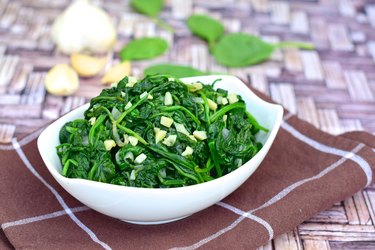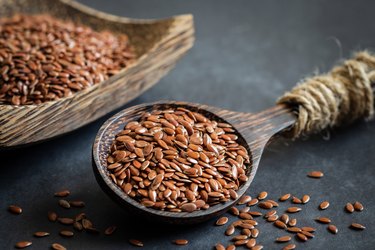Magnesium plays a critical role in our bodies: It regulates our muscle and nerve function, blood sugar levels and blood pressure as well as helps make protein, bone and DNA, according to the National Institutes of Health (NIH).
Despite how vital it is, most Americans don't get enough magnesium, which is why it's deemed a shortfall nutrient. Signs of low magnesium levels include appetite loss, nausea, vomiting, fatigue and weakness.
Video of the Day
Video of the Day
How Much Magnesium Do You Need?
Adults assigned male at birth need 400 to 420 milligrams of magnesium per day and adults assigned female at birth need 310 to 320 milligrams per day, according to the NIH.
And no, Epsom salt baths don't count as getting your magnesium fix. There seems to be no credible research that says transdermal magnesium (Epsom salt baths, creams, sprays) can help your body absorb it and reap the health benefits, according to an August 2017 study in Nutrients.
Take this list of foods high in magnesium on your next food shopping trip to get more of this mineral. Note that the FDA's Daily Value (DV) percentages are based on eating 420 milligrams of magnesium per day.
1. Spinach: 156.6 mg, 37% DV

Dark leafy greens are known for being nutritional powerhouses, and spinach is no exception.
Not only is Popeye's favorite food high in folate, but it's also a calcium-, iron-, zinc- and magnesium-rich food. This tasty vegan food high in magnesium provides 37 percent of your DV per cup cooked.
2. Squash and Pumpkin Seeds: 156.2 mg, 37% DV
Squash and pumpkin seeds are good sources of fiber, plant-based protein and iron. They offer 37 percent of the DV for magnesium per 1-ounce serving and are rich in healthy unsaturated fat, deeming them a keto food high in magnesium. Plus, they're easy to add to any dish: Mix them with your favorite trail mix or add atop your salads for crunch.
3. Lima Beans: 125.8 mg, 30% DV
Love 'em or hate 'em, lima beans are one of the best beans around when it comes to nutritional value. Cooked lima beans provide 37 percent of your daily fiber needs, 30 percent of your daily magnesium needs and nearly 12 grams of plant-based protein per 1 cooked cup. Try them in these deliciously easy bean recipes.
4. Black Beans: 120.4 mg, 29% DV
Black beans pair perfectly with rice for a hearty dish of complete protein, providing all nine essential amino acids, and filling fiber. Plus, 1 cup of cooked black beans contains 29 percent of the DV for magnesium. Eating pulses, like black beans, regularly can help with weight loss because they promote feeling full, according to a May 2016 study in the American Journal of Clinical Nutrition.
5. Quinoa: 118.4 mg, 28% DV
Quinoa, in all its colors, is a favorite for vegetarians and vegans because it offers complete protein. Quinoa is also rich in fiber. It has 28 percent of the DV for magnesium per 1 cooked cup.
Its versatility makes quinoa a good candidate for stir-fries, grain-based salads or complex-carb side dishes — and these delicious quinoa recipes.
6. Flaxseeds: 111.3 mg, 27% DV

Flaxseeds have a subtle nutty flavor, making them a good addition to your favorite oatmeal, yogurt, cereal or stir-fry. Not only does ground flaxseed mix more seamlessly into your dishes, but experts also say it's easier for your body to digest than whole flaxseed, according to the Mayo Clinic.
Flaxseeds offer unsaturated fat and fiber for heart health, as well as magnesium — 27 percent of the DV per 1-ounce serving.
7. Edamame: 99.2 mg, 24% DV
Edamame, or immature soybeans, is a popular appetizer at Japanese restaurants. They're simple, poppable and nutritious, thanks to their plant-based protein, fiber, iron and unsaturated fat.
One cup of cooked edamame provides 24 percent of the DV for magnesium.
Related Reading
8. Brown Rice: 85.8 mg, 20% DV
Brown rice is a whole grain, meaning it contains all three parts of the grain — the bran, endosperm and germ. The bran and the germ carry the most nutrients, including antioxidants, B vitamins, fiber and protein, according to the Whole Grains Council. When grains are refined (think: white flour and white rice), those nutritious parts are removed, leaving you with just the endosperm's starch.
A diet high in whole grains, like brown rice, is linked to a lower risk of dying from heart disease, according to a March 2015 study in JAMA Internal Medicine.
Plus, cooked brown rice contains 20 percent of the DV for magnesium per cup.
9. Almonds: 76.7 mg, 18% DV
Just one ounce of almonds (about a handful) gives you 18 percent of your magnesium DV. This crunchy nut is also rich in skin-healthy vitamin E, gut-nourishing fiber and energy-supporting vitamin B2.
10. Lentils: 71.3 mg, 17% DV
Lentils are a low-fat, high-fiber, protein-rich legume that works well in a variety of dishes. Cooked lentils offer 17 percent of the DV for magnesium per cup.
The legume comes in different colors, with slightly different benefits. For example, black lentils are rich in the antioxidant anthocyanin, which is often found in purple and blue foods, according to an August 2017 study in Food and Nutrition Research. Try it in these protein-rich lentil recipes.
11. Whole-Wheat Pasta: 63.2 mg, 15% DV
Just like brown rice, whole-wheat pasta is a whole grain. That means, compared to white pasta, it provides more nutrition, including fiber (4.6 grams versus 2.2 grams) and protein (8 grams versus 7 grams). The fiber and protein in whole-wheat pasta can help you feel full longer, according to the American Diabetes Association.
Even more, a 1-cup serving of cooked whole-wheat pasta has 15 percent of the DV for magnesium.
12. Dark Chocolate: 64.8 mg, 15% DV
Why yes, dark chocolate does have health benefits — when you choose the right kind. A 1-ounce serving of 70 to 85 percent dark chocolate provides heart-healthy antioxidants and 15 percent of the DV for magnesium.
Tip
For a tasty drink high in magnesium, try this Hot Chocolate with Cinnamon Sticks recipe.
13. Avocados: 58.3 mg, 14% DV

If you're a fan of the ever-popular avocado toast, you're reaping plenty of benefits from the nutrition avocados provide. The fruit (yes, avocado is a fruit!) is high in fat — 30 grams per avocado — but that fat is largely unsaturated, meaning it's good for your heart, according to an April 2018 review in the American Journal of Clinical Nutrition.
Avocados contain vitamins C and E, protein and more than 50 percent of the DV of fiber as well as 14 percent of the magnesium DV. Try it in these creative avo recipes.
14. Bananas: 40.5 mg, 10% DV
Bananas might be one of the most convenient, nutritious snacks made by nature, and there's no doubt they pair well with so much, including nut butter and honey. They're a popular fuel choice for athletes, thanks to their quick-acting carbs and potassium and other electrolytes, including magnesium, that might help prevent or stop muscle cramping.
In fact, bananas are a fruit high in magnesium: 1 cup offers 10 percent of the DV. One large banana has 9 percent of the DV. Try them in these tasty banana recipes.
See the foods high in magnesium chart below for the top 10.
The Top 10 Foods High in Magnesium
Food | Serving Size | Magnesium Content |
|---|---|---|
Spinach | 1 cup cooked | 156.6 mg, 37% DV |
Squash and Pumpkin Seeds | 1 ounce | 156.2 mg, 37% DV |
Lima Beans | 1 cup cooked | 125.8 mg, 30% DV |
Black Beans | 1 cup cooked | 120.4 mg, 29% DV |
Quinoa | 1 cup cooked | 118.4 mg, 28% DV |
Flaxseeds | 1 ounce | 111.3 mg, 27% DV |
Edamame | 1 cup cooked | 99.2 mg, 24% DV |
Brown Rice | 1 cup cooked | 85.8 mg, 20% DV |
Almonds | 1 ounce | 76.7 mg, 18% DV |
Lentils | 1 cup cooked | 71.3 mg, 17% DV |
- Nutrients: "Myth or Reality—Transdermal Magnesium?"
- U.S. Department of Health and Human Services: "2020-2025 Dietary Guidelines for Americans"
- National Institutes of Health: "Magnesium"
- Progress in Food and Nutrition Science: "Nutrition and Magnesium Absorption: A Review"
- American Journal of Clinical Nutrition: "Effects of Dietary Pulse Consumption on Body Weight: A Systematic Review and Meta-analysis of Randomized Controlled Trials"
- Mayo Clinic: "Does Ground Flaxseed Have More Health Benefits than Whole Flaxseed?"
- Washington State Department of Public Health: "Health Benefits of Fish"
- Nutrients: "Food Sources and Expenditures for Seafood in the United States"
- Whole Grains Council: "What's a Whole Grain? A Refined Grain?"
- JAMA Internal Medicine: "Association Between Dietary Whole Grain Intake and Risk of Mortality: Two Large Prospective Studies in US Men and Women"
- Food and Nutrition Research: "Anthocyanidins and Anthocyanins: Colored Pigments as Food, Pharmaceutical Ingredients, and the Potential Health Benefits"
- American Diabetes Association: "Get to Know Carbs"
- American Journal of Clinical Nutrition: "Avocado Consumption and Risk Factors for Heart Disease: A Systematic Review and Meta-analysis"
- Nutrition Research Review: "Dairy Products and Bone Health: How Strong is the Scientific Evidence?"
- American Heart Association: "Dairy Products - Milk, Yogurt, and Cheese"
- American Journal of Clinical Nutrition: "Serial Measures of Circulating Biomarkers of Dairy Fat and Total and Cause-specific Mortality in Older Adults: the Cardiovascular Health Study"
- Harvard Health Publishing: "Lycopene-rich Tomatoes Linked to Lower Stroke Risk"